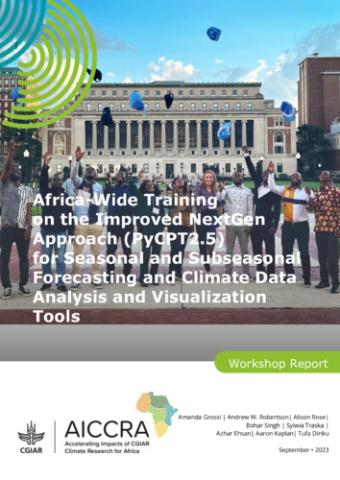Abstract
The Accelerating the Impact of CGIAR Climate Research for Africa (AICCRA) project aims to enhance access to climate information services and validated climate-smart agriculture technologies in Africa, to help these countries strengthen the resilience of their agricultural sectors to the threat posed by climate change. Towards these ends, the International Research Institute for Climate and Society (IRI), as part of Columbia Climate School at Columbia University, has been working closely with the national meteorological services in AICCRA target countries (Ethiopia, Kenya Zambia, Senegal, Ghana, Mali) alongside their associated regional climate centres (RCCs), the IGAD Climate Prediction and Applications Centre (ICPAC) in East Africa and the
Regional Centre for Training and Application in Agrometeorology and Operational Hydrology (AGRHYMET) in West Africa, to improve seasonal and subseasonal forecasting capacities using the NextGen (PyCPT) approach. The “NextGen” forecasting system, which is based on more than 25 years of research at the IRI, helps countries to quickly produce high-resolution, location-specific forecasts that can be easily communicated to agricultural decision makers and planners. Its state-of-the-art approach, which has already been adopted by more than a dozen countries in Central and Southern America and incorporated into the operational product suites of ICPAC (Hansen et al., 2022) and AGRHYMET (Segnon et al., 2022), helps forecasters assess past model performance, which can inform how best to correct and combine different global climate models. It also helps
forecasters select the best climate models for any region of interest through a process-based evaluation, and
it automates the generation and verification of tailored predictions at multiple timescales at the regional, national or sub-national level. And importantly, it is an open-source, community-owned and collaborative interface and approach for seasonal forecasting.
While AICCRA project investments in NextGen regional trainings in East and Southern Africa (ESA) in 2021 (Grossi et al., 2021) and 2022 (Grossi et al., 2022a) and West Africa in early (Minoungou et al., 2022) and late 2022 (Grossi et al., 2022b) resulted in significant increased regional forecasting capacity and the concomitant introduction of this high-need seasonal forecasting system to 18 national meteorological agencies and member states of both regions, one of the largest articulated demands, namely awareness and capacitation on the NextGen forecasting system at the subseasonal timescale (2-4 weeks of lead time) remained unmet. The generation of accurate and timely forecasts on this timescale is critical for the predictability of and early warnings for extreme, high-impact events such as recurrent droughts and floods that have plagued both regions.

